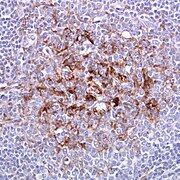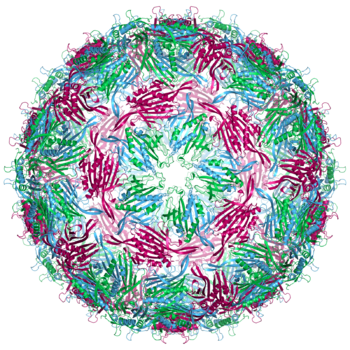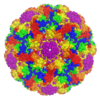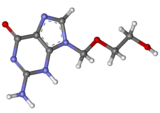The Viruses Portal
Welcome!

Viruses are small infectious agents that can replicate only inside the living cells of an organism. Viruses infect all forms of life, including animals, plants, fungi, bacteria and archaea. They are found in almost every ecosystem on Earth and are the most abundant type of biological entity, with millions of different types, although only about 6,000 viruses have been described in detail. Some viruses cause disease in humans, and others are responsible for economically important diseases of livestock and crops.
Virus particles (known as virions) consist of genetic material, which can be either DNA or RNA, wrapped in a protein coat called the capsid; some viruses also have an outer lipid envelope. The capsid can take simple helical or icosahedral forms, or more complex structures. The average virus is about 1/100 the size of the average bacterium, and most are too small to be seen directly with an optical microscope.
The origins of viruses are unclear: some may have evolved from plasmids, others from bacteria. Viruses are sometimes considered to be a life form, because they carry genetic material, reproduce and evolve through natural selection. However they lack key characteristics (such as cell structure) that are generally considered necessary to count as life. Because they possess some but not all such qualities, viruses have been described as "organisms at the edge of life".
Selected disease
Variant Creutzfeldt–Jakob disease, or vCJD, is a rare type of central nervous system disease within the transmissible spongiform encephalopathy family, caused by a prion. First identified in 1996, vCJD is now distinguished from classic CJD. The incubation period is believed to be years, possibly over 50 years. Prion protein can be detected in appendix and lymphoid tissue (pictured) up to two years before the onset of neurological symptoms, which include psychiatric problems, behavioural changes and painful sensations. Abnormal prion proteins build up as amyloid deposits in the brain, which acquires a characteristic spongiform appearance, with many round vacuoles in the cerebellum and cerebrum. The average life expectancy after symptoms start is 13 months.
About 170 cases have been recorded in the UK, and 50 cases in the rest of the world. The estimated prevalence in the UK is about 1 in 2000, higher than the reported cases. Transmission is believed to be mainly from consuming beef contaminated with the bovine spongiform encephalopathy prion, but may potentially also occur via blood products or contaminated surgical equipment. Infection is also believed to require a specific genetic susceptibility in the PRNP-encoding gene. Human PRNP protein can have either methionine or valine at position 129; nearly all of those affected had two copies of the methionine-containing form, found in 40% of Caucasians.
Selected image
The MS2 bacteriophage was the first virus genome to be sequenced in 1976. Its capsid has an icosahedral structure made up from 180 copies of the coat protein.
Credit: Neil Ranson (7 June 2011)
In the news
26 February: In the ongoing pandemic of severe acute respiratory syndrome coronavirus 2 (SARS-CoV-2), more than 110 million confirmed cases, including 2.5 million deaths, have been documented globally since the outbreak began in December 2019. WHO
18 February: Seven asymptomatic cases of avian influenza A subtype H5N8, the first documented H5N8 cases in humans, are reported in Astrakhan Oblast, Russia, after more than 100,0000 hens died on a poultry farm in December. WHO
14 February: Seven cases of Ebola virus disease are reported in Gouécké, south-east Guinea. WHO
7 February: A case of Ebola virus disease is detected in North Kivu Province of the Democratic Republic of the Congo. WHO
4 February: An outbreak of Rift Valley fever is ongoing in Kenya, with 32 human cases, including 11 deaths, since the outbreak started in November. WHO
21 November: The US Food and Drug Administration (FDA) gives emergency-use authorisation to casirivimab/imdevimab, a combination monoclonal antibody (mAb) therapy for non-hospitalised people twelve years and over with mild-to-moderate COVID-19, after granting emergency-use authorisation to the single mAb bamlanivimab earlier in the month. FDA 1, 2
18 November: The outbreak of Ebola virus disease in Équateur Province, Democratic Republic of the Congo, which started in June, has been declared over; a total of 130 cases were recorded, with 55 deaths. UN
Selected article
Infectious diseases are symptomatic diseases of an individual host resulting from the infection and replication of pathogens, including viruses, prions, bacteria, fungi, protozoa and multicellular parasites. Infectious diseases were responsible for 17% of human deaths globally in 2013, with HIV, measles and influenza being among the most significant viral causes of death.
Infectious pathogens must enter, survive and multiply within the host, and spread to fresh hosts. Relatively few microorganisms cause disease in healthy individuals, and infectious disease results from the interplay between these rare pathogens and the host's defences. Infection does not usually result in the host's death. The pathogen is generally cleared from the body by the host's immune system, although persistent infection occurs with several viruses. Transmission can occur by physical contact, contaminated food, water or objects, body fluids, airborne inhalation or via vectors, such as the mosquito (pictured). Diagnosis sometimes involves identifying the pathogen; techniques include culture, microscopy, immunoassays and PCR-based diagnostics.
Selected outbreak
The 2009 flu pandemic was an influenza pandemic first recognised in Mexico City in March 2009 and declared over in August 2010. It involved a novel strain of H1N1 influenza virus with genes from five different viruses, which resulted when a previous triple reassortment of avian, swine and human influenza viruses further combined with a Eurasian swine influenza virus, leading to the term "swine flu" being used for the pandemic. It was the second pandemic to involve an H1N1 strain, the first being the 1918 "Spanish flu" pandemic.
The global infection rate was estimated as 11–21%. This pandemic strain was less lethal than previous ones, killing about 0.01–0.03% of those infected, compared with 2–3% for Spanish flu. Most experts agree that at least 284,500 people died, mainly in Africa and Southeast Asia – comparable with the normal seasonal influenza fatalities of 290,000–650,000 – leading to claims that the World Health Organization had exaggerated the danger.
Selected quotation
| “ | ...in a flash I had understood: what caused my clear spots was, in fact, an invisible microbe, a filterable virus, but a virus parasitic on bacteria. | ” |
—Félix d'Herelle on the discovery of bacteriophages
Recommended articles
Viruses & Subviral agents: bat virome • elephant endotheliotropic herpesvirus • HIV • introduction to viruses![]() • Playa de Oro virus • poliovirus • prion • rotavirus
• Playa de Oro virus • poliovirus • prion • rotavirus![]() • virus
• virus![]()
Diseases: colony collapse disorder • common cold • croup • dengue fever![]() • gastroenteritis • Guillain–Barré syndrome • hepatitis B • hepatitis C • hepatitis E • herpes simplex • HIV/AIDS • influenza
• gastroenteritis • Guillain–Barré syndrome • hepatitis B • hepatitis C • hepatitis E • herpes simplex • HIV/AIDS • influenza![]() • meningitis
• meningitis![]() • myxomatosis • polio
• myxomatosis • polio![]() • pneumonia • shingles • smallpox
• pneumonia • shingles • smallpox
Epidemiology & Interventions: 2007 Bernard Matthews H5N1 outbreak • Coalition for Epidemic Preparedness Innovations • Disease X • 2009 flu pandemic • HIV/AIDS in Malawi • polio vaccine • Spanish flu • West African Ebola virus epidemic
Virus–Host interactions: antibody • host • immune system![]() • parasitism • RNA interference
• parasitism • RNA interference![]()
Methodology: metagenomics
Social & Media: And the Band Played On • Contagion • "Flu Season" • Frank's Cock![]() • Race Against Time: Searching for Hope in AIDS-Ravaged Africa
• Race Against Time: Searching for Hope in AIDS-Ravaged Africa![]() • social history of viruses
• social history of viruses![]() • "Steve Burdick" • "The Time Is Now" • "What Lies Below"
• "Steve Burdick" • "The Time Is Now" • "What Lies Below"
People: Brownie Mary • Macfarlane Burnet![]() • Bobbi Campbell • Aniru Conteh • people with hepatitis C
• Bobbi Campbell • Aniru Conteh • people with hepatitis C![]() • HIV-positive people
• HIV-positive people![]() • Bette Korber • Henrietta Lacks • Linda Laubenstein • Barbara McClintock
• Bette Korber • Henrietta Lacks • Linda Laubenstein • Barbara McClintock![]() • poliomyelitis survivors
• poliomyelitis survivors![]() • Joseph Sonnabend • Eli Todd • Ryan White
• Joseph Sonnabend • Eli Todd • Ryan White![]()
Selected virus
Tobacco mosaic virus (TMV) is an RNA virus in the Virgaviridae family that infects a wide range of plants, including tobacco, tomato, pepper, other members of the Solanaceae family, and cucumber. The rod-shaped virus particle is around 300 nm long and 18 nm in diameter, and consists of a helical capsid made from 2130 copies of a single coat protein, which is wrapped around a positive-sense single-stranded RNA genome of around 6400 bases. The coat protein and RNA can self-assemble to produce infectious virus.
Infection often causes characteristic patterns, such as "mosaic"-like mottling and discoloration on the leaves, but is almost symptomless in some host species. TMV causes an economically important disease in tobacco plants. Transmission is frequently by human handling, and prevention of infection involves destroying infected plants, hand washing and crop rotation to avoid contaminated soil. TMV is one of the most stable viruses known. The fact that it does not infect animals and can readily be produced in gramme amounts has led to its use in numerous pioneering studies in virology and structural biology. TMV was the first virus to be discovered and the first to be crystallised.
Did you know?
- ...that murine polyomavirus (pictured) is an oncovirus that causes tumours in newborn mice?
- ...that Pat Nuttall showed that systemic infection of the host is not required for pathogens such as tick-borne encephalitis virus to be transmitted between vectors?
- ...that the first person to die in Australia from the 2009 flu was a Pintupi man whose people gave up hunting to settle the remote community of Kiwirrkura at the time of his birth?
- ...that the 2011 film Asmaa is the first feature-length Egyptian drama film to present AIDS patients sympathetically?
- ...that the anti-vaccine book Melanie's Marvelous Measles has received over 1,000 one-star reviews on Amazon.com?
Selected biography
Peter Piot (born 17 February 1949) is a Belgian virologist and public health specialist, known for his work on Ebola virus and HIV.
During the first outbreak of Ebola in Yambuku, Zaire in 1976, Piot was one of a team that discovered the filovirus in a blood sample. He and his colleagues travelled to Zaire to help to control the outbreak, and showed that the virus is transmitted via blood and during preparation of bodies for burial. He advised WHO during the West African Ebola epidemic of 2014–16.
In the 1980s, Piot participated in collaborative projects in Burundi, Côte d'Ivoire, Kenya, Tanzania and Zaire, including Project SIDA in Kinshasa, the first international project on AIDS in Africa, which provided the foundations for understanding HIV infection in that continent. He was the founding director of UNAIDS, and has served as president of the International AIDS Society and assistant director of the WHO Global HIV/AIDS Programme. As of 2020, he directs the London School of Hygiene & Tropical Medicine.
In this month
5 June 1981: First report of HIV/AIDS (symbol pictured) appeared in medical literature
6 June 1997: Gene silencing in plants shown to be a viral defence mechanism
7–13 June 1962: Donald Caspar and Aaron Klug proposed the quasi-equivalence principle of virus structure
7–13 June 1962: André Lwoff proposed a viral classification scheme based on nature of genome, type of symmetry and presence of envelope
7–13 June 1962: George Hirst proposed that the influenza virus genome is segmented
9 June 1981: The American Society for Virology was founded
13 June 2012: First case of Middle East respiratory syndrome coronavirus (MERS-CoV) occurred in Saudi Arabia
18 June 1981: A vaccine against foot-and-mouth disease was the first genetically engineered vaccine
21 June 1996: Nevirapine approved, first NNRTI for HIV/AIDS
26 June 1993: Clinical trial of hepatitis B virus drug fialuridine terminated; the drug caused several fatalities due to lactic acidosis
28 June 2011: FAO declared rinderpest eradicated
30 June 1985: Ryan White was denied re-admittance to his school after an AIDS diagnosis, in a case that changed public perceptions of the disease
Selected intervention
Aciclovir (also acyclovir and sold as Zovirax) is a nucleoside analogue that mimics the nucleoside guanosine. It is active against most viruses in the herpesvirus family, and is mainly used to treat herpes simplex virus infections, chickenpox and shingles. After phosphorylation by viral thymidine kinase and cellular enzymes, the drug inhibits the viral DNA polymerase. Extremely selective and low in cytotoxicity, it was seen as the start of a new era in antiviral therapy. Aciclovir was discovered by Howard Schaeffer and colleagues, and developed by Schaeffer and Gertrude Elion, who was awarded the 1988 Nobel Prize in Medicine in part for its development. Nucleosides isolated from a Caribbean sponge, Cryptotethya crypta, formed the basis for its synthesis. Aciclovir differs from earlier nucleoside analogues in containing only a partial nucleoside structure: the sugar ring is replaced with an open chain. Resistance to the drug is rare in people with a normal immune system.
Subcategories
Subcategories of virology:
Topics
Things to do
- Comment on what you like and dislike about this portal
- Join the Viruses WikiProject
- Tag articles on viruses and virology with the project banner by adding {{WikiProject Viruses}} to the talk page
- Assess unassessed articles against the project standards
- Create requested pages: red-linked viruses | red-linked virus genera
- Expand a virus stub into a full article, adding images, citations, references and taxoboxes, following the project guidelines
- Create a new article (or expand an old one 5-fold) and nominate it for the main page Did You Know? section
- Improve a B-class article and nominate it for Good Article
 or Featured Article
or Featured Article status
status - Suggest articles, pictures, interesting facts, events and news to be featured here on the portal
WikiProjects & Portals
 WikiProject Viruses
Related WikiProjects
WikiProject Viruses
Related WikiProjects
Medicine • Microbiology • Molecular & Cellular Biology • Veterinary Medicine
Related PortalsAssociated Wikimedia
The following Wikimedia Foundation sister projects provide more on this subject:
-
Commons
Free media repository -
Wikibooks
Free textbooks and manuals -
Wikidata
Free knowledge base -
Wikinews
Free-content news -
Wikiquote
Collection of quotations -
Wikisource
Free-content library -
Wikispecies
Directory of species -
Wikiversity
Free learning tools -
Wiktionary
Dictionary and thesaurus


















